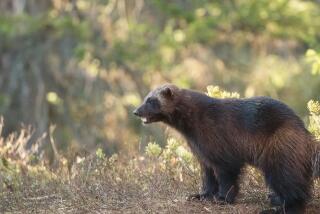Norton Seeks to Halt Grizzly Plan
- Share via
WASHINGTON — Interior Secretary Gale A. Norton on Wednesday proposed rescinding a plan to reintroduce grizzly bears into the Bitterroot ecosystem of central Idaho and western Montana.
Her proposal, if carried out, would roll back yet another Clinton administration environmental action. It is certain to anger environmentalists who believe the Bitterroot initiative is the best strategy for expanding the habitat of the grizzly, a threatened species.
“It’s the area best suited to reestablishing a robust grizzly population,” said Tom France, a National Wildlife Federation representative who helped draft the plan to manage the reintroduction. “This is very, very disappointing.”
Norton defended her decision by stressing she wants to focus on efforts to bolster existing grizzly bear populations, rather than start new ones.
“The grizzlies deserve the best opportunities for their populations to thrive and prosper, and I am fully committed to the recovery of grizzly bears in the Lower 48,” she said.
The reversal was sought by Idaho Gov. Dirk Kempthorne, who sued the government to halt the reintroduction of what he called “massive, flesh-eating carnivores.”
Norton’s decision reflected her belief that a successful reintroduction program could not occur without strong local support, according to Meg Durham, spokeswoman for the U.S. Fish and Wildlife Service, the Interior Department agency charged with protecting endangered and threatened species.
The public will have a 60-day comment period before a final decision is reached. Norton’s proposal is likely to doom the plan, although Durham said future reintroduction of the species in the Bitterroot area has not been ruled out.
Idaho politicians praised Norton’s decision.
“It is critical that any grizzly recovery program be achieved through building consensus rather than federal edict,” said Sen. Michael D. Crapo (R-Idaho).
Wildlife advocates decried the reversal, saying it would undermine efforts to return the grizzly bear to the Lower 48. “This is extremely damaging to grizzly bear conservation,” said Bob Ferris of Defenders of Wildlife, an environmental group that focuses on threatened and endangered species.
Ferris said it was especially disturbing that Norton rejected this particular plan, because it was developed over several years with the participation of local logging companies and would have been administered by a 15-member citizen management committee.
Norton has advocated increased local participation in Interior Department decision-making to develop consensus among various “stakeholders”--including environmentalists, landowners, business interests and local officials.
“Logically, this should have been a program that she embraced,” Ferris said.
In a November statement, the Fish and Wildlife Service said the Selway-Bitterroot wilderness area “has the best potential for grizzly bear recovery” of all unoccupied grizzly habitat in the Lower 48, and would contribute to the species’ recovery.
“The biology has not changed; what has changed is the policy,” Durham said. “When you reintroduce a species you have to have a lot of [local] support and cooperation and that was a concern in this case.”
An estimated 50,000 grizzly bears lived in what is now the contiguous United States before European settlement. The population has dwindled to an estimated 1,100 grizzlies in the Lower 48, scattered among five separate populations concentrated in Montana, Idaho, Wyoming and Washington.
Under the Bitterroot reintroduction plan, at least 25 bears would have been introduced in the area over five years, with the first ones arriving next summer. The goal was the reach a grizzly population of 280 over the next 50 to 100 years.
“It’s one of the last areas in North America where we can put bears where there isn’t a lot of livestock and there aren’t a lot of people, and we can have a fair expectation that they might survive,” Ferris said.
Grizzlies are omnivores whose food choices range from berries to dead animals to insects. Adults, weighing between 250 and 600 pounds, have front claws that are at least 4 inches long and humps between high shoulders.
The grizzlies’ advocates said they are determined to keep working to return the bears to the Bitterroot area, even if they have to wait for a new administration to take over in Washington.
“We will continue to fight on,” Ferris said.
The plan for reintroducing the grizzly bears to Bitterroot was one of dozens of environmental regulations, rules and actions finalized or proposed in the final months of the Clinton administration.
The Bush administration has acted to weaken, strike or suspend a number of them, including efficiency standards for air conditioners, regulations to protect the environment from gold and other hard rock mining, standards for allowable quantities of arsenic in drinking water and regulations banning logging and road building from backwoods, roadless areas of national forests.
More to Read
Sign up for Essential California
The most important California stories and recommendations in your inbox every morning.
You may occasionally receive promotional content from the Los Angeles Times.













